Page 643 of 761
642 Practical hints
What to do if …?
Display Possible cause/consequencePossible solution
STOP,
car too lowYou have started driving although the vehi-
cle level was too low.
The vehicle will be raised. The Airmatic
warning lamp goes out after several sec-
onds.�Stop your vehicle as soon as it is safe to do
so.
�Engage the electronic parking brake
(
�page 395).
�Wait until the message disappears from the
multifunction display.
You may then drive off.
STOP,
car too lowThe Airmatic is malfunctioning.
The Airmatic warning lamp lights up contin-
uously.�Stop and press the vehicle level control but-
ton to select a higher vehicle level
(
�page 440).
�Do not turn steering wheel too far to avoid
damaging the front fenders.
�Listen for scraping noises.
�Do not exceed a speed of 50 mph (80 km/h).
�Contact an authorized Mercedes-Benz
Center as soon as possible.
There is otherwise danger of an accident.
Page 646 of 761
645 Practical hints
What to do if …?
Display Possible cause/consequencePossible solution
Coolant,
please refill
See Oper. ManualThe coolant level is too low.�Add coolant (�page 547).
�If you have to add coolant frequently, have
the cooling system checked by an authorized
Mercedes-Benz Center.
Warning!G
Do not spill antifreeze on hot engine parts.
Antifreeze contains ethylene glycol which
may burn if it comes into contact with hot
engine parts. You could be seriously burned.
!Do not ignore the low engine coolant level
warning. Extended driving with the message and
symbol displayed may cause serious engine
damage not covered by the Mercedes-Benz Lim-
ited Warranty.
Do not drive without a sufficient amount of cool-
ant in the cooling system. The engine will over-
heat, causing major engine damage.
Page 647 of 761
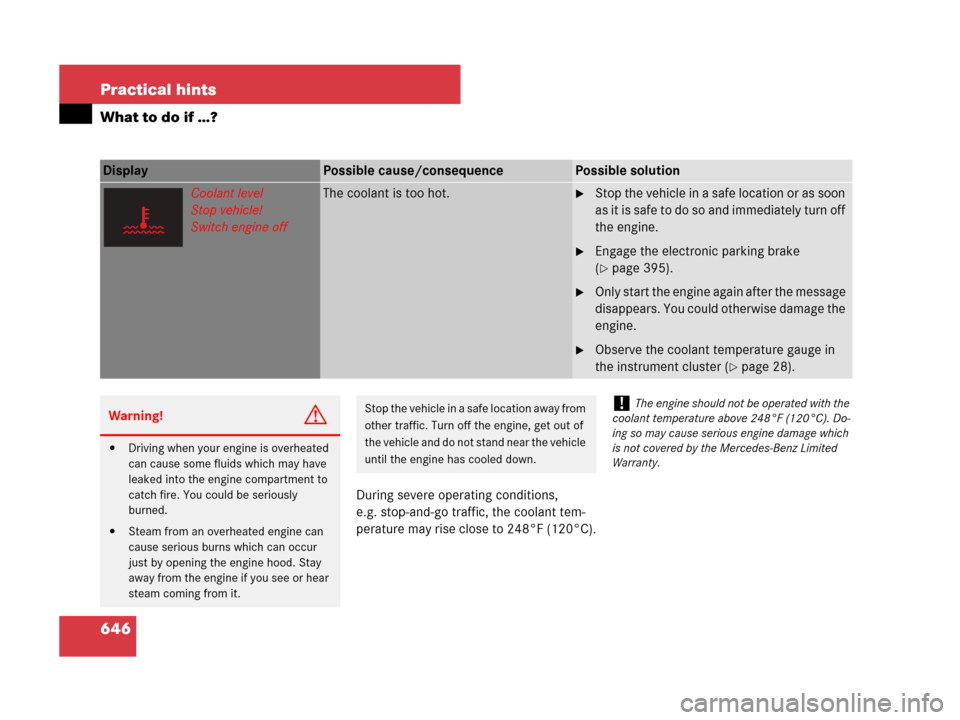
646 Practical hints
What to do if …?
During severe operating conditions,
e.g. stop-and-go traffic, the coolant tem-
perature may rise close to 248°F (120°C).
Display Possible cause/consequencePossible solution
Coolant level
Stop vehicle!
Switch engine offThe coolant is too hot. �Stop the vehicle in a safe location or as soon
as it is safe to do so and immediately turn off
the engine.
�Engage the electronic parking brake
(
�page 395).
�Only start the engine again after the message
disappears. You could otherwise damage the
engine.
�Observe the coolant temperature gauge in
the instrument cluster (
�page 28).
Warning!G
�Driving when your engine is overheated
can cause some fluids which may have
leaked into the engine compartment to
catch fire. You could be seriously
burned.
�Steam from an overheated engine can
cause serious burns which can occur
just by opening the engine hood. Stay
away from the engine if you see or hear
steam coming from it.
Stop the vehicle in a safe location away from
other traffic. Turn off the engine, get out of
the vehicle and do not stand near the vehicle
until the engine has cooled down.!The engine should not be operated with the
coolant temperature above 248°F (120°C). Do-
ing so may cause serious engine damage which
is not covered by the Mercedes-Benz Limited
Warranty.
Page 661 of 761
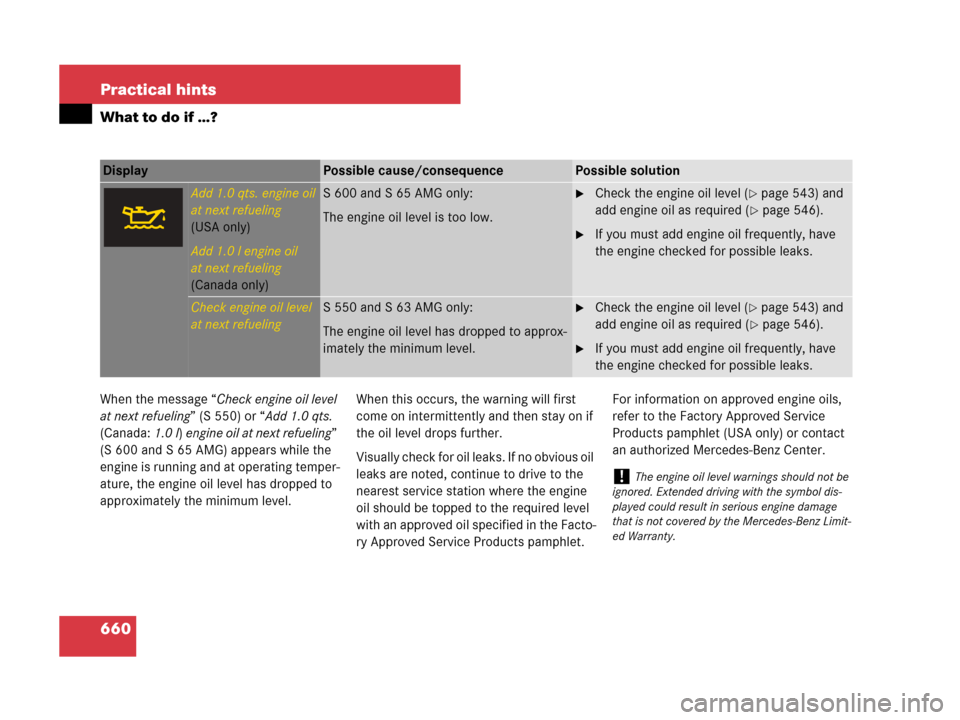
660 Practical hints
What to do if …?
When the message “Check engine oil level
at next refueling” (S 550) or “Add 1.0 qts.
(Canada:1.0 l) engine oil at next refueling”
(S 600 and S 65 AMG) appears while the
engine is running and at operating temper-
ature, the engine oil level has dropped to
approximately the minimum level.When this occurs, the warning will first
come on intermittently and then stay on if
the oil level drops further.
Visually check for oil leaks. If no obvious oil
leaks are noted, continue to drive to the
nearest service station where the engine
oil should be topped to the required level
with an approved oil specified in the Facto-
ry Approved Service Products pamphlet.For information on approved engine oils,
refer to the Factory Approved Service
Products pamphlet (USA only) or contact
an authorized Mercedes-Benz Center.
Display Possible cause/consequencePossible solution
Add 1.0 qts. engine oil
at next refueling
(USA only)
Add 1.0 l engine oil
at next refueling
(Canada only)S600 and S65AMG only:
The engine oil level is too low.�Check the engine oil level (�page 543) and
add engine oil as required (
�page 546).
�If you must add engine oil frequently, have
the engine checked for possible leaks.
Check engine oil level
at next refuelingS550 and S63 AMG only:
The engine oil level has dropped to approx-
imately the minimum level.�Check the engine oil level (�page 543) and
add engine oil as required (
�page 546).
�If you must add engine oil frequently, have
the engine checked for possible leaks.
!The engine oil level warnings should not be
ignored. Extended driving with the symbol dis-
played could result in serious engine damage
that is not covered by the Mercedes-Benz Limit-
ed Warranty.
Page 663 of 761
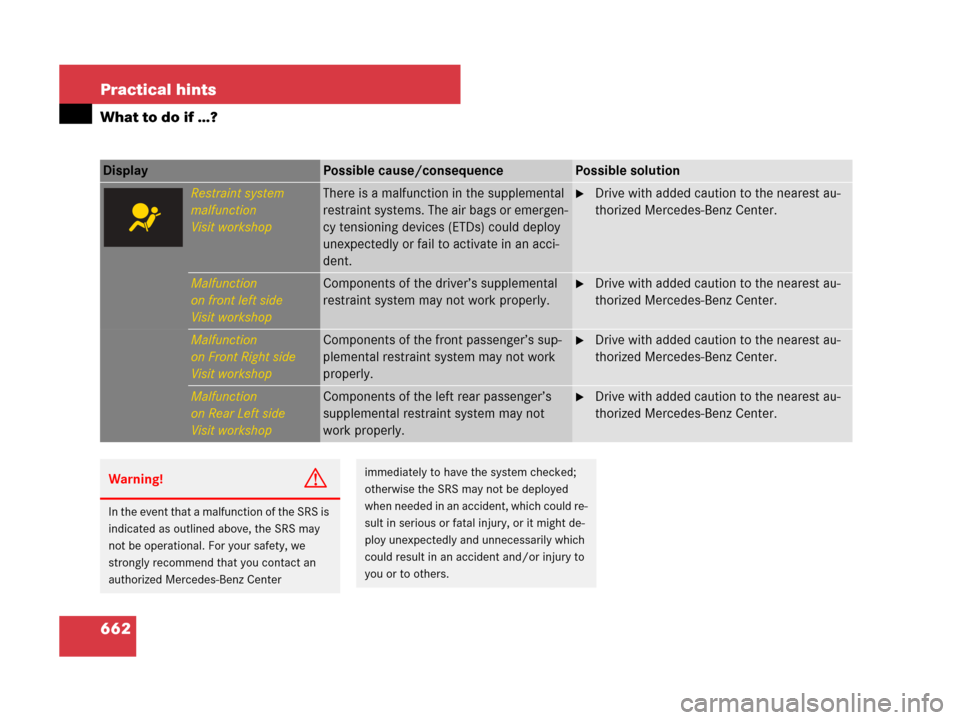
662 Practical hints
What to do if …?
Display Possible cause/consequencePossible solution
Restraint system
malfunction
Visit workshopThere is a malfunction in the supplemental
restraint systems. The air bags or emergen-
cy tensioning devices (ETDs) could deploy
unexpectedly or fail to activate in an acci-
dent.�Drive with added caution to the nearest au-
thorized Mercedes-Benz Center.
Malfunction
on front left side
Visit workshopComponents of the driver’s supplemental
restraint system may not work properly.�Drive with added caution to the nearest au-
thorized Mercedes-Benz Center.
Malfunction
on Front Right side
Visit workshopComponents of the front passenger’s sup-
plemental restraint system may not work
properly.�Drive with added caution to the nearest au-
thorized Mercedes-Benz Center.
Malfunction
on Rear Left side
Visit workshopComponents of the left rear passenger’s
supplemental restraint system may not
work properly.�Drive with added caution to the nearest au-
thorized Mercedes-Benz Center.
Warning!G
In the event that a malfunction of the SRS is
indicated as outlined above, the SRS may
not be operational. For your safety, we
strongly recommend that you contact an
authorized Mercedes-Benz Center
immediately to have the system checked;
otherwise the SRS may not be deployed
when needed in an accident, which could re-
sult in serious or fatal injury, or it might de-
ploy unexpectedly and unnecessarily which
could result in an accident and/or injury to
you or to others.
Page 664 of 761
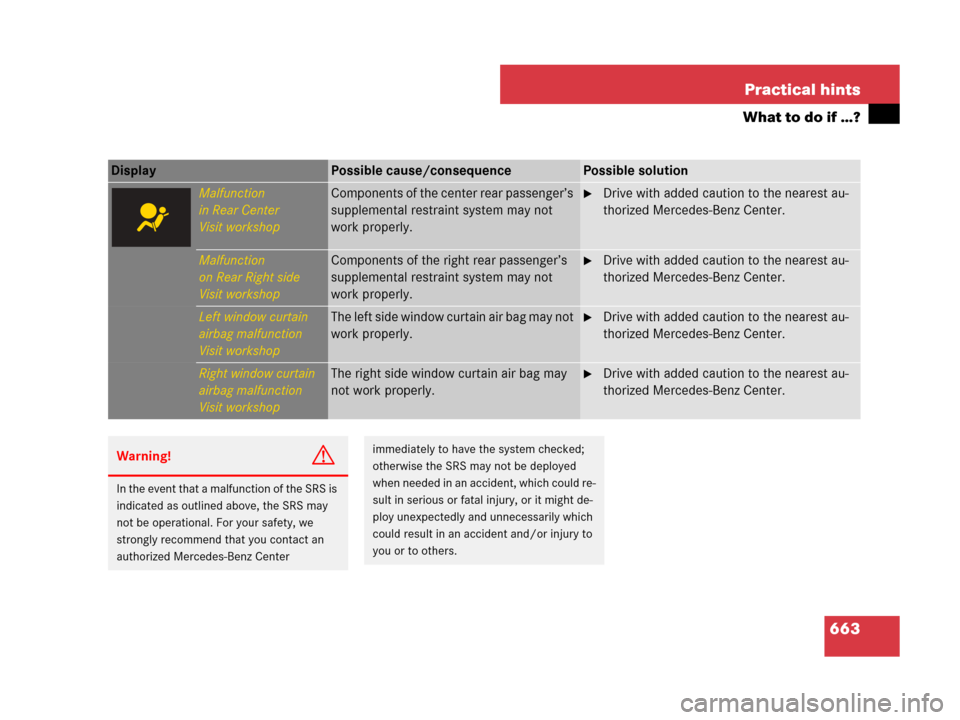
663 Practical hints
What to do if …?
Display Possible cause/consequencePossible solution
Malfunction
in Rear Center
Visit workshopComponents of the center rear passenger’s
supplemental restraint system may not
work properly.�Drive with added caution to the nearest au-
thorized Mercedes-Benz Center.
Malfunction
on Rear Right side
Visit workshopComponents of the right rear passenger’s
supplemental restraint system may not
work properly.�Drive with added caution to the nearest au-
thorized Mercedes-Benz Center.
Left window curtain
airbag malfunction
Visit workshopThe left side window curtain air bag may not
work properly.�Drive with added caution to the nearest au-
thorized Mercedes-Benz Center.
Right window curtain
airbag malfunction
Visit workshopThe right side window curtain air bag may
not work properly.�Drive with added caution to the nearest au-
thorized Mercedes-Benz Center.
Warning!G
In the event that a malfunction of the SRS is
indicated as outlined above, the SRS may
not be operational. For your safety, we
strongly recommend that you contact an
authorized Mercedes-Benz Center
immediately to have the system checked;
otherwise the SRS may not be deployed
when needed in an accident, which could re-
sult in serious or fatal injury, or it might de-
ploy unexpectedly and unnecessarily which
could result in an accident and/or injury to
you or to others.
Page 665 of 761
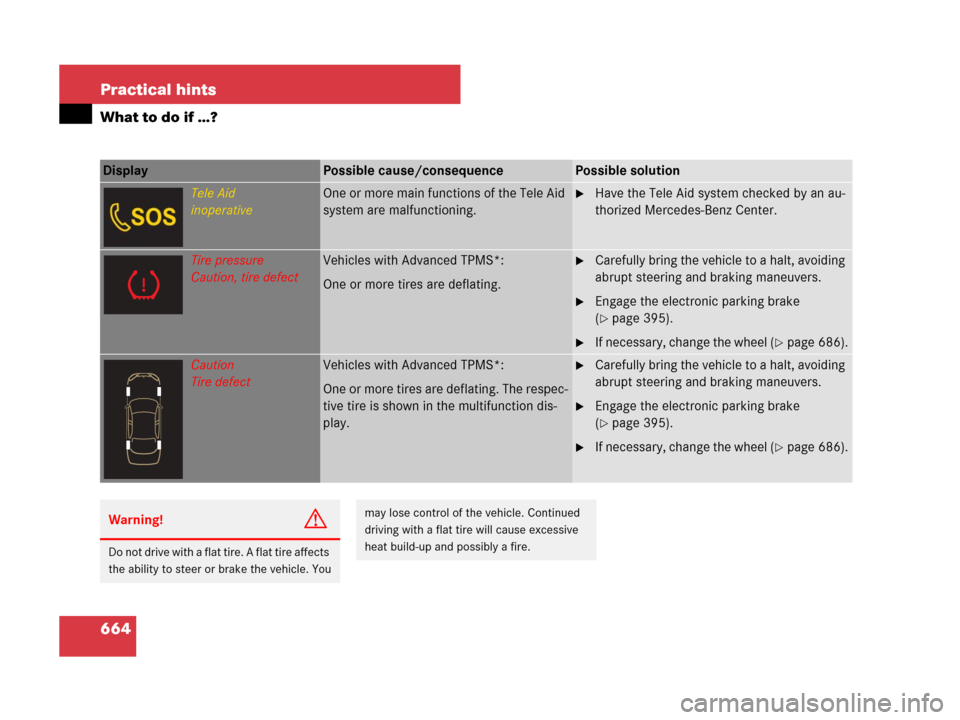
664 Practical hints
What to do if …?
Display Possible cause/consequencePossible solution
Tele Aid
inoperativeOne or more main functions of the Tele Aid
system are malfunctioning.�Have the Tele Aid system checked by an au-
thorized Mercedes-Benz Center.
Tire pressure
Caution, tire defectVehicles with Advanced TPMS*:
One or more tires are deflating.�Carefully bring the vehicle to a halt, avoiding
abrupt steering and braking maneuvers.
�Engage the electronic parking brake
(
�page 395).
�If necessary, change the wheel (�page 686).
Caution
Tire defectVehicles with Advanced TPMS*:
One or more tires are deflating. The respec-
tive tire is shown in the multifunction dis-
play.�Carefully bring the vehicle to a halt, avoiding
abrupt steering and braking maneuvers.
�Engage the electronic parking brake
(
�page 395).
�If necessary, change the wheel (�page 686).
Warning!G
Do not drive with a flat tire. A flat tire affects
the ability to steer or brake the vehicle. You
may lose control of the vehicle. Continued
driving with a flat tire will cause excessive
heat build-up and possibly a fire.
Page 666 of 761

665 Practical hints
What to do if …?
Display Possible cause/consequencePossible solution
Tire pressure
Check tiresVehicles with Advanced TPMS*:
The pressure is too low in one or more tires.�Carefully bring the vehicle to a halt, avoiding
abrupt steering and braking maneuvers.
�Engage the electronic parking brake
(
�page 395).
�Check and adjust tire inflation pressure as
required (
�page 561).
�If necessary, change the wheel (�page 686).
Check tiresVehicles with Advanced TPMS*:
The pressure is too low in one or more tires.
The respective tire is shown in the multi-
function display.�Carefully bring the vehicle to a halt, avoiding
abrupt steering and braking maneuvers.
�Engage the electronic parking brake
(
�page 395).
�Check and adjust tire inflation pressure as
required (
�page 561).
�If necessary, change the wheel (�page 686).
Warning!G
Do not drive with a flat tire. A flat tire affects
the ability to steer or brake the vehicle. You
may lose control of the vehicle. Continued
driving with a flat tire will cause excessive
heat build-up and possibly a fire.